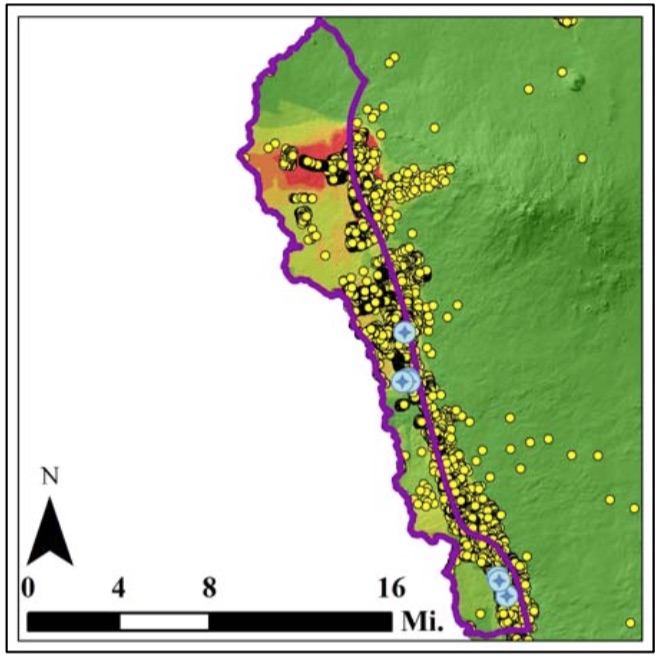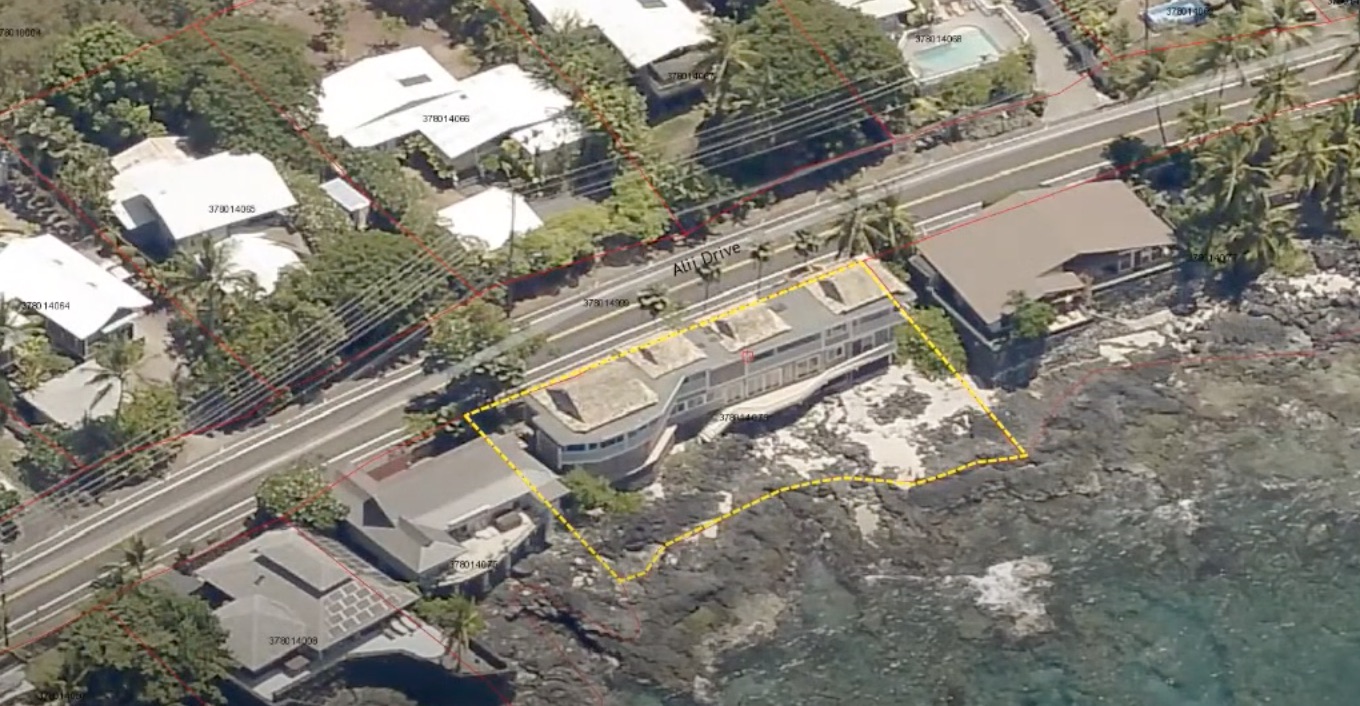(This article has been changed to correct the spelling of John Pipan’s name.)
Which has the greater value? Keeping a private swimming pool, to be used by a handful of guests at an exclusive Kona bed-and-breakfast that sits practically on the shore?
Or converting a cesspool that receives the sewage generated by those guests into a septic system that would provide at least some treatment of the waste before it enters the ocean?
The question arose last month as the Hawaiʻi County Leeward Planning Commission considered what upgrades should be placed as conditions on a permit to allow homeowner Arthur H. Arejian, a high-powered real estate broker in Southern California, to rent out four of the five bedrooms in the 2,000-square-foot house fronting Kahaluʻu Bay to as many as 10 guests a night.
The public would surely benefit more from the cesspool, but removing the pool to allow installation of a septic system – well, “that’s a big ask” of the homeowner, said Arejian’s agent, John Pipan.
It’s not even certain that removing the pool that lies between the house and Kona’s Aliʻi Drive would be possible, given required setbacks and leach fields.
Commission chair Michael Vitousek recognized the problems that shoreline cesspools pose to water quality. “For a cesspool on a lot at the shore, the time for the sewage to reach the ocean is basically zero,” he said. As part of $150,000 in upgrades to the house planned in connection with the B&B, “maybe now is the time to request this. It would at least slow the leach of cesspool material into the ocean.”
According to the application, the house sits on a 14,530-square-foot lot, with the house itself just outside a 20-foot setback from the shoreline, last certified some 36 years ago. That lot size of roughly a third of an acre, however, refers to the property line set when the lot was first subdivided decades ago by then-landowner Bishop Estate. For decades, much of that theoretical property has been submerged. At the time shoreline certifications were made in 1979 and again in 1985, the ocean had claimed more than half of the lot. Aerial photos today show the house sitting atop unvegetated rocks.
Were a shoreline survey to be done today, it is unlikely to show any distance at all between house and sea.
Pipan pointed out this “additional wrinkle” in obtaining approvals for a septic system. “To design and actually install a septic system there is going to be a little tricky, given the space constraints,” he said. “If we plan to put in a septic system, this is going to instigate another round of Special Management Area permitting. The Planning Department will likely look at that certified shoreline from the 1980s and request that it be updated. A new shoreline may be closer to the dwelling and could put the backside of the dwelling within the 40-foot mandatory shoreline setback. And then we’d be in the position where state law prohibits us from putting in a septic system because it’s too close to the shoreline. So what do we do in that situation? We would have to a) prepare an environmental assessment and b) seek a shoreline setback variance…. So it’s not that we’re averse to doing this. It’s a good idea. It’s just that there are complicating factors, namely the shoreline setback.”
Bryan Lindsey, the architect designing the improvements to the house, told the commission, “There is no area, obviously, on the ocean side for installing anything.” On the Aliʻi Drive side of the property, “there’s not much room… The feasibility doesn’t look great.”
Alex Roy, the Planning Department staffer who presented the department’s recommendation for approval to the commission, noted that the cantilevered lanai of the house was already up against the 20-foot setback in 1985. “A 40-foot setback,” what is now required, “would bring us somewhere just under the house structure, possibly even further,” he said.
Anyway, “by converting from a cesspool to more of a drainfield structure, there seems to be some confusion that getting rid of the cesspool and putting in a new drainfield system would somehow alleviate material going into the water. That’s not the case. It still would be leaching in, just in a much broader area,” he said.
Extending the sewer service “is the best way to deal with septic issues,” he said. But the county’s sewer line, connecting to the Kealakehe wastewater treatment plant, ends some 1,200 feet to the north along Aliʻi Drive. The line connecting to the private Keauhou sewage treatment plant is about the same distance to the south.
Deputy planning director April Surprenant was asked about the county’s plans to extend the public sewer to this area. “We are considering some things in the next round of the general plan,” she said, but “we’re not ready to reveal that or discuss all of that quite yet. But those are part of the considerations going into our long-range plans as a whole. For now all we can go by is the direction and codes, laws, and rules as provided by the Department of Health.” The state requires all cesspools, including the 49,000 in Hawaiʻi County, to be eliminated by 2050.
Roy spoke against the idea of requiring Arejian to upgrade the home’s cesspool. “To put the burden on the applicant, when they have very little room, may lead to future problems that would take a lot more engineering to resolve,” Roy said. “There’s just not the space to do something. If they have to deconstruct the house to put a septic system under it, the impacts from that process alone could be more detrimental.”
“You’re pretty much banking on the possibility of connecting to one of the two sewers, north or south, in the future,” commissioner Nancy Carr Smith said.
“Not necessarily,” Pipan replied. “Like I said, we’re not opposed to converting to a septic system. The trick is, not having complete knowledge of where the certified shoreline lies right now would make that incredibly difficult, if even possible. A condition could be written such that if sufficient space, after a certified shoreline survey is conducted, is available to accommodate a septic system, then it would be installed given a timeline…
“Obviously a sewer system is ideal. There are dozens and dozens of homes along this stretch of Aliʻi Drive that have no improved wastewater system. Many of those homes are million dollar homes. It makes sense for the county to have an improvement district, a contribution from each owner. These things are probably beyond scope of this permit, but I think there could be some condition that should an improvement district be established, the applicant would contribute his fair share to extend the sewer to his property.”
Carr Smith then asked if Pipan and his client had considered using the pool area for a septic system.
“We haven’t spoken to an engineer,” Pipan said. This is going to be a much bigger impact on the Special Management Area, decommissioning the cesspool, digging up the driveway in the parking area. We would have to rely on Mr. Arejian to see if he were amenable to losing the pool. I don’t know, that’s a pretty big ask. We can defer to him.” Arejian, who was present on the Zoom screen, did not weigh in on this question.
Commissioner Mark Van Pernis objected to the idea of not requiring immediate upgrades of the cesspool, noting that Arejian could be expected to have income of $20,000 to $30,000 a month, so “he should be able to handle the cost.”
In response to concerns about the cesspool, Pipan suggested that the permit include a condition requiring installation of an upgraded system only if it were determined to be feasible. “I would not like to put the applicant in a tough situation by agreeing to upgrade the system but have him not be able to do so due to the shoreline,” Pipan said.
Commission chair Vitousek elaborated on the matter of feasibility. It would not include asking the homeowner to tear down anything, he said. Rather, feasibility would include using just the area “outside of the space of the existing home and improvements,” and pursuing “variances of setbacks if needed to allow the conversion.”
As approved by the commission, the permit requires Arejian to make a fair-share contribution to a sewer district “if and when one is formed” near his property. In the meantime, he is to upgrade to a septic system within five years, “if determined feasible within the space provided.”
Kona Cesspools
Along almost all of Aliʻi Drive in Kona, residential cesspools discharge human waste to the sea with virtually no treatment. However, those make up just a small part of the 6,500 cesspools in the Kona area that release some 4 million gallons of wastewater to the ocean each day. That represents about 1,210 pounds of nitrogen and some 600 pounds of phosphorus that go into the nearshore waters, to say nothing of pathogens and pharmaceuticals carried in human waste.
Those figures come from a Department of Health report in 2017 that identified Kailua-Kona as a priority area for cesspool conversion.
Since then, there has been no push by the county or the state to require homeowners to upgrade to septic systems that would treat the sewage, at least minimally. Nor has municipal sewer service been extended in the area.

— Patricia Tummons


Leave a Reply